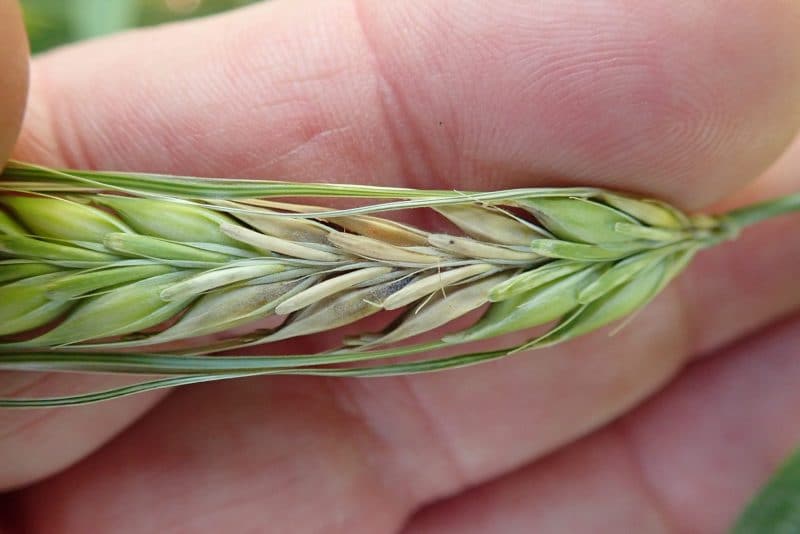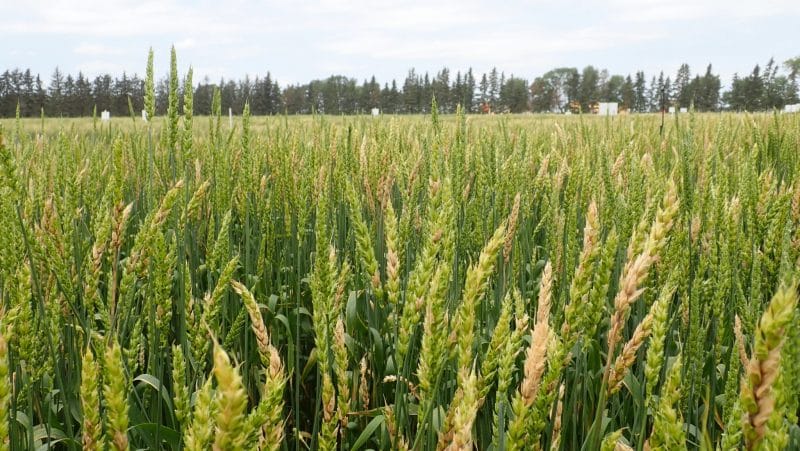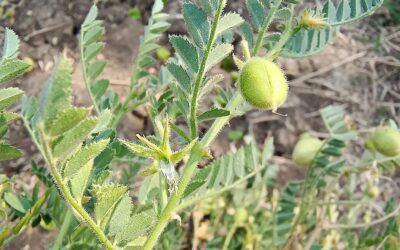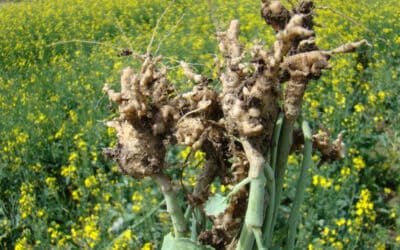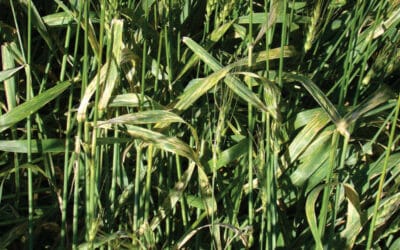Two Alberta experts share their views on best practices for managing the fungal disease in cereal crops.
Fusarium head blight (FHB) is a growing threat in Alberta. This serious fungal disease of wheat, barley, oats and corn first appeared in southern Alberta crops in the 1990s and has been slowly spreading north and west since then.
While there is no “silver bullet” available to growers to ward off FHB in their crops, there are steps they can take to reduce the impact of disease.
According to Kelly Turkington, an Agriculture and Agri-Food Canada plant pathology researcher based in Lacombe, Alta., the two primary weapons used to combat FHB, fungicides and resistant varieties, don’t provide the same measure of control they do for some other important cereal diseases.
That’s why Turkington believes an integrated approach that utilizes a series of best practices from seeding to residue management at harvest offers the best chance of success for FHB control.
We asked Turkington as well as Clair Langlois, a cereal extension specialist with Alberta Agriculture and Forestry, about management practices they feel can help growers minimize the presence and effect of FHB on their farms.
Resistant Varieties
Turkingtonbelieves the first line of defence against FHB is to grow varieties with the best available level of resistance against Fusarium graminearum, the predominant Fusarium species in Alberta.
Emerson is a winter wheat rated Resistant (R) to FHB and AAC Tenacious is a Canadian Prairie Spring Red variety that also has a R rating. There are a number of other spring wheat varieties rated Moderately Resistant (MR), and among the durums, Intermediate is the best rating.
Turkington says resistance to FHB is harder to achieve in wheat than it is for some other pathogens, so the level of disease control typically isn’t as high as it would be for a stripe rust resistant variety, for example. But he says when used as part of a disease management program, varieties with an R or MR rating still offer some assurance against F. graminearum infection.
“That doesn’t guarantee you won’t have problems, but it greatly reduces your risk compared to a highly susceptible variety,” says Turkington.
Healthy Seed
Turkington states another key to FHB control is using good quality certified seed, or at the least, seed tested for the Fusarium pathogen.
“To fully understand what you’re facing in your field or in your area, that means testing, making sure the seed you’re planting is tested for F. graminearum,” he says.
Langlois agrees it’s important for growers to dotheir due diligence when procuring secure seed.
When buying certified seed, he says growers should ask for a seed health report with testing results specifically for F. graminearum. Using seed of the highest quality with high germination and vigor scores, and the lowest disease levels as possible. Langlois also recommends growers keep a representative sample of the seed they purchased.
In addition, Langloisbelieves it’s a good idea for growers who opt to test their seed to ask their seed labs to perform both an Agar-plate test and a DNA test, since this will not only tell you if F. graminearum is present in the seed, but just how much of it is there.
Seed Treatment
Langlois says regardless of whether FHB is present in an area, it’s a good practice for growers to always treat their seed with a registered fungicide that includes Fusarium control on the label. He says this will not only help avert seedling blight but also reduce the potential spread of F. graminearum in a field or area that hasn’t had it before.
Another benefit of using treated seed is it can help cereal crops get off to a good start and in a better position to ward off FHB.
“You want to start off with good, high-quality seed and then couple that with a good quality seed treatment using good application technology, which will help ensure rapid uniform seed germination, seedling growth and emergence, and stand establishment,” Turkington says.
“If you have a high level of Fusarium infection, and you’ll pick that up in your seed tests, you’ll see a reduction in germination. Seed treatments can help mitigate some of that if the level of infection isn’t too high.”
Seeding Rates
Langlois recommends growers utilize higher seedings rates, since this will promote a more uniform stand, reduce tillering in plants, and result in a shorter flowering period for the crop (which is the key growth stagefor F. graminearum).
As Turkington points out, uniform crop development will ensure more uniform head emergence and a more uniform target for farmers spraying fungicides to limit FHB later on in the growing season.
“You need to get fungicide on the plant tissue you want to protect. If plant tissue is still in the boot, it’s totally unprotected, and the fungicide will be deposited on the flag leaf sheath instead. You need to have head tissues physically out so you can spray fungicide on them,” Turkington says.
“If you use a lower seeding rate, that means there’s more secondary development and a wider window for potential infection to occur since there’s a much more variable target.”
Turkington recommends growers avoid planting seed too deep, since this can also result in more variable stand establishment.
He suggests growers pay close attention to the amount of seed-placed fertilizer to avoid phyto-toxicity that high levels of seed-placed fertilizer may cause.
“You want to have good separation of your seed and fertilizer, especially nitrogen. This will help to promote more even germination and better stand establishment,” says Turkington.
Sprayer Technology
Turkington stresses when applying fungicides in-season to fight FHB, it’s essentialto make sure the field sprayer is working properly and calibrated correctly, so the fungicide is distributed as evenly and accurately as possible.
He says spray nozzles and nozzle combinations that maximize spray coverage on all sides of the wheat heads are particularly effective.
“You need to look at an angled nozzle setup,” says Turkington. “The fungicides we’re using provide suppression at best. That may just be the nature of the disease we’re trying to control and the target we’re trying to hit, which is more of a vertical target. That’s why it’s important to use the right nozzle technology to try and improve coverage.”
Limiting Residue
Turkington says because F. graminearum can overwinter in crop stubble, anything that can be done to facilitate decomposition of this residue will help remove a potential source of inoculant. He says one of the steps growers can take is to chop up crop residue and spread it widely over the field.
“The smaller the pieces, the better, because the more rapidly it will decompose,” says Turkington. “If you get good spread of the material, you won’t have the thick sort of swath of chaff that might take a bit longer to decompose in subsequent growing seasons.”
Crop Rotation
Allowing more time for crop stubble to break down before reintroducing another cereal crop to the field is another way to reduce the risk of Fusarium infection. Langlois says a short or continuous rotation of cereal crops can allow for a buildup of F. graminearum on infested residues, so it’s recommended growers leave at least two years between host crops.
Because corn is also susceptible to F. graminearum, Langlois says it should be avoided in rotation with small grain cereals.
“You have to be careful what you pick for a rotation, and corn is definitely not one,” he says.
Turkington agrees. “If you look at history, corn is an important host for Fusarium graminearum, and that means it’s an important host crop for subsequent small grain cereal crops in terms of future risk. So certainly, corn exacerbates the risk you may have.”
For many Alberta grain farmers, canola is a popular rotation choice with cereals. Both Langlois and Turkington say field peas are an excellent rotational crop growers should consider as well.
Field location can also be an important consideration for FHB control since wind-blown F. graminearum spores can easily travel from one field to the next. Langlois says for this reason, it makes sense for growers to try to avoid planting small grain cereals right beside cereal or corn fields where F. graminearum levels are known or suspected to be high.
Combination of Practices
Turkington says in those areas where the fusarium pathogen is well established, relying on crop rotation alone is likely not enough when it comes to FHB prevention.
“You might have a good rotation, at least two, if not three years between susceptible crops, but your neighbour next door may not necessarily be following that type of crop rotation,” he says. “What you might find are spores literally being blown across a gravel road from one field to one that’s immediately adjacent, and those fields would be most at risk.”
Turkington says that’s why using multiple tactics to fight FHB is the most effective strategy, and he’s optimistic with new research into areas like variety development, seed health and enhanced agronomic practices, farmers will eventually have a larger and more effective toolbox to work with.
“In Alberta, Fusarium head blight is a big issue that can cause some significant problems,” he says. “The tools we have [to fight it] do not necessarily work as well as we would like them to right now, but there’s lots of research and activity going into improving that, so I’m hopeful.”
###
To: All agricultural producers in Alberta
Re: Fusarium graminearum status in Alberta
Fusarium graminearum (Fg) was declared a pest in the Pest and Nuisance Control Regulation under the Agricultural Pest Act in Alberta as an eradication strategy in 1999. Since then, infection levels and spread of the pathogen are increasing across Alberta. For example, in 2016, 26.5 per cent1 of cereal fields surveyed, and 85.3 per cent1of corn fields inspected contained the pathogen. Forecasts for 2019 point towards a higher incidence of infection in high rainfall areas of Alberta, especially in crops that received rain during flowering.
Alberta Seed Growers and Alberta Seed Processors through their work in a multi-faceted industry working group launched by the Alberta Wheat Commission have put forward the following request of the Alberta Government:
Modernize the current Pest and Nuisance Control Regulation to move away from a seed-infection based regulatory approach to mitigation and management. Instead, we recommend a focus on the use of best management practices to control the disease.
This regulatory change would allow for the free and transparent movement of seed with minor levels of Fg infection for propagation & research. It would also emphasize a focus on the more effective disease management of employing best management practice tools.
Following are the consequences of maintaining status quo of Fg as a pest in the current Pest and Nuisance Control Regulation:
Economic Disadvantage for Alberta Producers
- Alberta farmers are at a competitive disadvantage to access newer varieties available to farmers in other provinces; it is becoming more difficult to find pedigreed seed that has non-detectable levels of Fg.
- High quality pedigreed seed with very low infection levels of Fg. (0.5 per cent) is being shipped out of province or dumped as commercial grain, leaving farmers with less opportunity to purchase pedigreed seed.
- Maintaining a focus only on seed infection increases the risk of producing fusarium infected crops, as it takes the focus off wind-borne spore infection from infected cereal & corn fields.
Alberta’s Seed Industry is Not Sustainable
o Seed growers are finding it increasingly difficult to find higher generations of the newer varieties with improved fusarium resistance, resorting to growing older varieties; which does not help farmers trying to manage fusarium.
o Seed production companies are at a tipping point where it is next to impossible to justify multiplying varieties in Alberta where they are at substantial risk of producing seed with detectable levels of fusarium. These new seed varieties, when detectable levels of fusarium are present, are then shipped out of province, where out-of-province producers are at a huge advantage of gaining quicker access.
Please join us, along with other members of the fusarium working group, to support the amendment of the Pest and Nuisance Control Regulation to address the current fusarium reality. Email your support for change or any comments to the fusarium working group: [email protected].
1 Harding, Michael; Research Scientist, Plant Pathology Crop Research and Extension Branch Alberta Agriculture and Forestry Summary of Surveys for Fusarium Head Blight caused by Fusarium graminearum in Alberta Wheat Fields, ACIDF Project # 2015C017R


